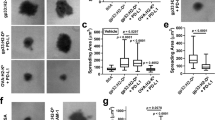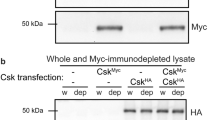Abstract
Lymphoid tyrosine phosphatase (LYP) and C-terminal Src kinase (CSK) are negative regulators of signaling mediated through the T-cell antigen receptor (TCR) and are thought to act in a cooperative manner when forming a complex. Here we studied the spatiotemporal dynamics of the LYP–CSK complex in T cells. We demonstrate that dissociation of this complex is necessary for recruitment of LYP to the plasma membrane, where it downmodulates TCR signaling. Development of a potent and selective chemical probe of LYP confirmed that LYP inhibits T-cell activation when removed from CSK. Our findings may explain the reduced TCR-mediated signaling associated with a single-nucleotide polymorphism that confers increased risk for certain autoimmune diseases, including type 1 diabetes and rheumatoid arthritis, and results in expression of a mutant LYP that is unable to bind CSK. Our compound also represents a starting point for the development of a LYP-based treatment of autoimmunity.
This is a preview of subscription content, access via your institution
Access options
Subscribe to this journal
Receive 12 print issues and online access
$259.00 per year
only $21.58 per issue
Buy this article
- Purchase on Springer Link
- Instant access to full article PDF
Prices may be subject to local taxes which are calculated during checkout







Similar content being viewed by others
Accession codes
Change history
30 March 2012
In the version of this article initially published online, the C1858 allele of PTPN22 was inadvertently referred to as the Cys1858 allele in the results section "Effects of LTV-1 on TCR signaling in primary human T cells". The error has been corrected in the HTML and PDF versions of the article.
References
Mustelin, T., Vang, T. & Bottini, N. Protein tyrosine phosphatases and the immune response. Nat. Rev. Immunol. 5, 43–57 (2005).
Smith-Garvin, J.E., Koretzky, G.A. & Jordan, M.S. T cell activation. Annu. Rev. Immunol. 27, 591–619 (2009).
Vang, T. et al. Protein tyrosine phosphatases in autoimmunity. Annu. Rev. Immunol. 26, 29–55 (2008).
Cloutier, J.F. & Veillette, A. Association of inhibitory tyrosine protein kinase p50csk with protein tyrosine phosphatase PEP in T cells and other hemopoietic cells. EMBO J. 15, 4909–4918 (1996).
Gregorieff, A., Cloutier, J.F. & Veillette, A. Sequence requirements for association of protein-tyrosine phosphatase PEP with the Src homology 3 domain of inhibitory tyrosine protein kinase p50(csk). J. Biol. Chem. 273, 13217–13222 (1998).
Ghose, R., Shekhtman, A., Goger, M.J., Ji, H. & Cowburn, D. A novel, specific interaction involving the Csk SH3 domain and its natural ligand. Nat. Struct. Biol. 8, 998–1004 (2001).
Bottini, N. et al. A functional variant of lymphoid tyrosine phosphatase is associated with type I diabetes. Nat. Genet. 36, 337–338 (2004).
Vang, T. et al. Autoimmune-associated lymphoid tyrosine phosphatase is a gain-of-function variant. Nat. Genet. 37, 1317–1319 (2005).
Rieck, M. et al. Genetic variation in PTPN22 corresponds to altered function of T and B lymphocytes. J. Immunol. 179, 4704–4710 (2007).
Arechiga, A.F. et al. Cutting edge: the PTPN22 allelic variant associated with autoimmunity impairs B cell signaling. J. Immunol. 182, 3343–3347 (2009).
Côté, J.F. et al. PSTPIP is a substrate of PTP-PEST and serves as a scaffold guiding PTP-PEST toward a specific dephosphorylation of WASP. J. Biol. Chem. 277, 2973–2986 (2002).
Arimura, Y., Vang, T., Tautz, L., Williams, S. & Mustelin, T. TCR-induced downregulation of protein tyrosine phosphatase PEST augments secondary T cell responses. Mol. Immunol. 45, 3074–3084 (2008).
Davidson, D., Cloutier, J.F., Gregorieff, A. & Veillette, A. Inhibitory tyrosine protein kinase p50csk is associated with protein-tyrosine phosphatase PTP-PEST in hemopoietic and non-hemopoietic cells. J. Biol. Chem. 272, 23455–23462 (1997).
Chow, L.M., Fournel, M., Davidson, D. & Veillette, A. Negative regulation of T-cell receptor signalling by tyrosine protein kinase p50csk. Nature 365, 156–160 (1993).
Vang, T. et al. Activation of the COOH-terminal Src kinase (Csk) by cAMP-dependent protein kinase inhibits signaling through the T cell receptor. J. Exp. Med. 193, 497–507 (2001).
Tautz, L. & Mustelin, T. Strategies for developing protein tyrosine phosphatase inhibitors. Methods 42, 250–260 (2007).
Willett, P. Similarity-based virtual screening using 2D fingerprints. Drug Discov. Today 11, 1046–1053 (2006).
Vang, T. et al. Inhibition of lymphoid tyrosine phosphatase by benzofuran salicylic acids. J. Med. Chem. 54, 562–571 (2011).
Abagyan, R., Totrov, M. & Kuznetsov, D. ICM—a new method for protein modeling and design: applications to docking and structure prediction from the distorted native conformation. J. Comput. Chem. 15, 488–506 (1994).
Barr, A.J. et al. Large-scale structural analysis of the classical human protein tyrosine phosphatome. Cell 136, 352–363 (2009).
Heinonen, K.M., Bourdeau, A., Doody, K.M. & Tremblay, M.L. Protein tyrosine phosphatases PTP-1B and TC-PTP play nonredundant roles in macrophage development and IFN-gamma signaling. Proc. Natl. Acad. Sci. USA 106, 9368–9372 (2009).
Bourdeau, A., Dube, N. & Tremblay, M.L. Cytoplasmic protein tyrosine phosphatases, regulation and function: the roles of PTP1B and TC-PTP. Curr. Opin. Cell Biol. 17, 203–209 (2005).
Zhang, J. et al. The autoimmune disease-associated PTPN22 variant promotes calpain-mediated Lyp/Pep degradation associated with lymphocyte and dendritic cell hyperresponsiveness. Nat. Genet. 43, 902–907 (2011).
Todd, J.A. et al. Robust associations of four new chromosome regions from genome-wide analyses of type 1 diabetes. Nat. Genet. 39, 857–864 (2007).
Tautz, L., Pellecchia, M. & Mustelin, T. Targeting the PTPome in human disease. Expert Opin. Ther. Targets 10, 157–177 (2006).
Vintonyak, V.V., Antonchick, A.P., Rauh, D. & Waldmann, H. The therapeutic potential of phosphatase inhibitors. Curr. Opin. Chem. Biol. 13, 272–283 (2009).
Yu, X. et al. Structure, inhibitor, and regulatory mechanism of Lyp, a lymphoid-specific tyrosine phosphatase implicated in autoimmune diseases. Proc. Natl. Acad. Sci. USA 104, 19767–19772 (2007).
Liu, S. et al. Targeting inactive enzyme conformation: aryl diketoacid derivatives as a new class of PTP1B inhibitors. J. Am. Chem. Soc. 130, 17075–17084 (2008).
Wu, S., Bottini, M., Rickert, R.C., Mustelin, T. & Tautz, L. In silico screening for PTPN22 inhibitors: active hits from an inactive phosphatase conformation. ChemMedChem 4, 440–444 (2009).
Zhang, X. et al. Salicylic acid based small molecule inhibitor for the oncogenic Src homology-2 domain containing protein tyrosine phosphatase-2 (SHP2). J. Med. Chem. 53, 2482–2493 (2010).
Fiorillo, E. et al. Autoimmune-associated PTPN22 R620W variation reduces phosphorylation of lymphoid phosphatase on an inhibitory tyrosine residue. J. Biol. Chem. 285, 26506–26518 (2010).
Zikherman, J. et al. PTPN22 deficiency cooperates with the CD45 E613R allele to break tolerance on a non-autoimmune background. J. Immunol. 182, 4093–4106 (2009).
Cloutier, J.F. & Veillette, A. Cooperative inhibition of T-cell antigen receptor signaling by a complex between a kinase and a phosphatase. J. Exp. Med. 189, 111–121 (1999).
Gjörloff-Wingren, A., Saxena, M., Williams, S., Hammi, D. & Mustelin, T. Characterization of TCR-induced receptor-proximal signaling events negatively regulated by the protein tyrosine phosphatase PEP. Eur. J. Immunol. 29, 3845–3854 (1999).
Gregersen, P.K. & Olsson, L.M. Recent advances in the genetics of autoimmune disease. Annu. Rev. Immunol. 27, 363–391 (2009).
Tautz, L. et al. Inhibition of Yersinia tyrosine phosphatase by furanyl salicylate compounds. J. Biol. Chem. 280, 9400–9408 (2005).
Viken, M.K. et al. The PTPN22 promoter polymorphism -1123G>C association cannot be distinguished from the 1858C>T association in a Norwegian rheumatoid arthritis material. Tissue Antigens 70, 190–197 (2007).
Acknowledgements
We thank L. Smith and the Exploratory Pharmacology Core at Sanford-Burnham Medical Research Institute for support and thoughtful discussions; S. Ormenese and the Groupe Interdisciplinaire de Génoprotéomique Appliquée Imaging Core for their help with flow cytometry; and G.M. Tjørhom, S.T. Flåm and J. Solheim for technical assistance. This work was supported by the US National Institutes of Health (grant 1R21CA132121 to L.T.), the Norwegian Cancer Society (T.V.), the American Cancer Society (research scholar grant RSG-08-067-01-LIB to R.P.), the Oxnard Foundation (research grant to T.M./R.C.R.), the Belgian Research National Scientific Fund (Mandat d'Impulsion Scientifique Young Investigator Starting Grant to S.R.) and the Liège University (startup grant to S.R.).
Author information
Authors and Affiliations
Contributions
T.V., W.H.L., L.D., S.W., R.D., B.A.L., S.R. and L.T. designed research, performed research, analyzed data and wrote the paper; S.V., L.Y., L.M., D.F. and J.L. designed research, performed research and analyzed data; K.T. and M.L.T. contributed new reagents or analytical tools; R.P. designed research, analyzed data and wrote the paper; and T.M. and R.C.R. designed research.
Corresponding author
Ethics declarations
Competing interests
The authors declare no competing financial interests.
Supplementary information
Supplementary Text and Figures
Supplementary Methods and Supplementary Results (PDF 7617 kb)
Rights and permissions
About this article
Cite this article
Vang, T., Liu, W., Delacroix, L. et al. LYP inhibits T-cell activation when dissociated from CSK. Nat Chem Biol 8, 437–446 (2012). https://doi.org/10.1038/nchembio.916
Received:
Accepted:
Published:
Issue Date:
DOI: https://doi.org/10.1038/nchembio.916
This article is cited by
-
The genetics of Graves’ disease
Reviews in Endocrine and Metabolic Disorders (2024)
-
Targeting protein phosphatases in cancer immunotherapy and autoimmune disorders
Nature Reviews Drug Discovery (2023)
-
SH3-domain mutations selectively disrupt Csk homodimerization or PTPN22 binding
Scientific Reports (2022)
-
Protein tyrosine phosphatases (PTPs) in diabetes: causes and therapeutic opportunities
Archives of Pharmacal Research (2021)
-
The expression patterns and the diagnostic/prognostic roles of PTPN family members in digestive tract cancers
Cancer Cell International (2020)



